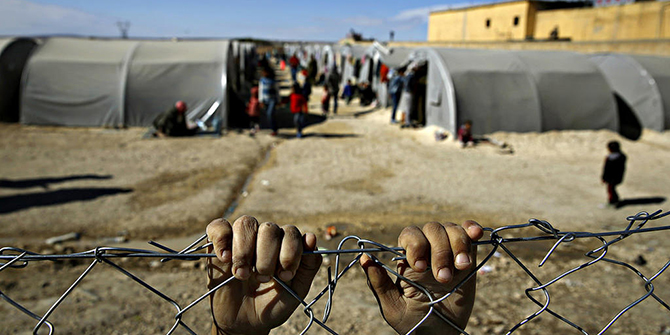Professor Sadek Al-Azm spoke at LSE last week and reflected on the Arab uprisings, the current situation in Syria and what he called ‘good-for-business’ Islam. The following is a snippet from his lecture which is available as a full transcript here. In addition to his talk at LSE, Al-Azm also recently wrote a piece which appeared in the online journal, Reason Papers.
If, in fact, we Arabs are on the verge of a new era of politics, I find it then necessary to draw the serious attention of the newly emerging forces of the Arab Spring to two highly related, deeply ingrained and highly regressive tendencies in Arab political life in general.
The first tendency, as past experience has shown, is for Arab political changes and shifts to proceed in spite of inflated rhetoric and hyperbolic discourses, to proceed on the basis of the famous French maxim which says: ‘plus ca change, plus c’est la meme chose’. The second tendency can be summarized in a few telling words: the persistence of the ancient regime. No matter what, and even after the revolution has worked itself out, we can already see the persistence of the ancien régime asserting itself in Egypt now and in Cairo’s Tahrir Square opposing. Cairo’s Tahrir Square, in a certain sense, is the paradigm for all the other Tahrir squares of the Arab world during this last period.
It is clear to me now that the military ancien régime in Egypt sacrificed a part of itself in order to save the rest of itself. Another means of persistence is for the ancien régime to technically withdraw to its barracks and leave the front stage to civil society, civil politicians, political parties and electoral politics, but still wield power behind the scenes. In other words, we may very well have in Egypt a situation similar to the one that prevailed in Turkey before the Justice and Development Party won power electorally in the country.
That is, without the upmost careful attention to these two regressive, engrained tendencies in Arab political life, the inauguration of a new era of Arab politics where various Arab peoples may have finally found their voice and are in the process of affirming it, this new process will be hindered, distorted and even reversed. Let me add that the worst and most damaging form of the persistence of the ancien régime is when it persists in the very lives, behaviour, habits and decisions of the revolutionaries themselves. Actually, this has been a very common and prevalent Arab failure as we all ought to know from our own experiences with past Arab revolutions, or so-called revolutions, and past Arab revolutionaries.
Now I move on to confess that the unfolding of the Arab Spring often takes me back to what I had learned and got to know about classical European revolutionary politics and the intellectual energies expended on the theorisation of these politics. Tahrir Square experiences seem to me to come nearest to the venerable European debates, theories and practices of the general strike. The revolution in Syria has no Tahrir Square as yet. The Syrian revolutionary experience now seems to come closest to the theory and practice of the revolutionary [inaudible], especially as first expounded by Régis Debray in his early work ‘Revolution in the Revolution’.
Again, the revolution in Syria is often accused of being spontaneous, leaderless and lacking in strategy, but then is there not, in all this, an echo of classical European revolutionary politics, debates and controversies over the role of the leading highly organised vanguard party as against the natural spontaneity of the revolutionary politics, debates and controversies over the role of the leading, highly organized vanguard party as against the natural spontaneity of the revolutionary masses. Do not the formation and the rise of the Syrian tensikiyat – that is the local coordinating committees – does not this ring a bell of sorts in some European minds as they seem to come nearest to the again venerable idea of local revolutionary councils that operate regardless of what the traditional political organizations, opposition groups and personalities say or do?
In Syria today, these tensikiyat lead and energise the street power of the revolution and are responsible for sustaining the, on the whole, non-violent character of the intifada against military rules, martial law, the police state that Syria has been for the last half century. Given the spontaneity of these tensikiyat, still they have been able to knit themselves into a national network continually in touch with similar activists both in Syria, the Arab World, as well as the wide-world beyond. Using with great expertise the most up-to date electronic forms of communication to further their revolutionary agenda, they have been able as well to frustrate the military regime’s efforts to block and suppress the flow of information. They achieved that by sustaining a steady flow of real time images and vital pieces of information concerning what is actually taking place on the ground, all around the country.
One last reflection concerning these kinds of comparisons. The revolution in Syria today reminds me very strongly of the Arab revolutionary politics of the 1950s and 1960s of the last century, particularly Egypt and Syria. Remember that Egypt and Syria at that time formed a short-lived union called then the United Arab Republic. The major enemy of the revolutionaries, activists and progressives of those days was called tahalouf al iktaa wal bourgeousie – that is the alliance of the feudal lords with the high bourgeoisie of that time, an alliance that once dominated the politics, power and wealth of those countries to the detriment of everyone else. Now I can say with confidence that today’s revolution in Syria or intifiada in Syria is again directed against a similar alliance of new military feudal lords with a state-formed high bourgeoisie which arrogantly, vainly, hotly and insolently dominates the politics, powers and wealth of the country to the detriment of everyone else as well. An alliance that I once called in its earlier stages the merchant-military complex that really rules Syria while the activists and commentators of a younger generation – that is the activists and commentators of today – have come to call the merchant-military conference al mourakkab al siyasi al amni al mali – that is the political security financial complex.
Conspiciously absent from the Arab Spring and from its Tahrir Squares and its revolutionary focus in Syria are the traditional cries, slogans, demands and banners of good old Arab nationalism, especially as we have known it over the famous nationalist period of the last century. It was in its heyday in the early post-colonial era in Egypt and Syria. So just as no banner was raised anywhere from Tunis to Cairo to Tripoli, Libya to Sanaa to Manama, Bahrain and to Homs, Syria, no banner was raised saying ‘Islam is the solution’. Similarly, no banner was in sight either saying ‘Arab unity is the solution’.
Actually, it is remarkable that what was on exhibit through the Arab Spring are metamorphosed and both more interesting and more sublimated expressions of a different kind of Arab unity than usual or than we have been accustomed to. First, the Arab regimes being put to the test by the intifadas of their peoples showed a peculiar kind of official Arab unity after years of vociferous rhetoric about the basic unity of Al Umma Al Arabiah – the Arab nation –and about its unifying historical commonalities such as language, religion, ethnicity, culture and shared destiny and all the rest. These same Arab regimes seemed united in going on a rhetorical binge emphasising Arab particularities, peculiarities, uniquenesses, singularities and so on.
 Born in Damascus in 1934, Al-Azm is Professor Emeritus of Modern European Philosophy at the University of Damascus and is currently a fellow at the Centre for Advanced Studies, University of Bonn. He was a Visiting Professor in Princeton University’s Near Eastern Studies Department until 2008. His seminal book, Self-Criticism After the Defeat, has recently been translated into English and published by Saqi. When it was first published in 1968, the book marked a turning point in Arab discourse about society and politics and spawned other intellectual ventures into Arab self-criticism. In 1970, Al-Azm was tried in Beirut and dismissed from his teaching post the American University of Beirut in response to his writings. Many of his works are still banned in the Arab world.
Born in Damascus in 1934, Al-Azm is Professor Emeritus of Modern European Philosophy at the University of Damascus and is currently a fellow at the Centre for Advanced Studies, University of Bonn. He was a Visiting Professor in Princeton University’s Near Eastern Studies Department until 2008. His seminal book, Self-Criticism After the Defeat, has recently been translated into English and published by Saqi. When it was first published in 1968, the book marked a turning point in Arab discourse about society and politics and spawned other intellectual ventures into Arab self-criticism. In 1970, Al-Azm was tried in Beirut and dismissed from his teaching post the American University of Beirut in response to his writings. Many of his works are still banned in the Arab world.







